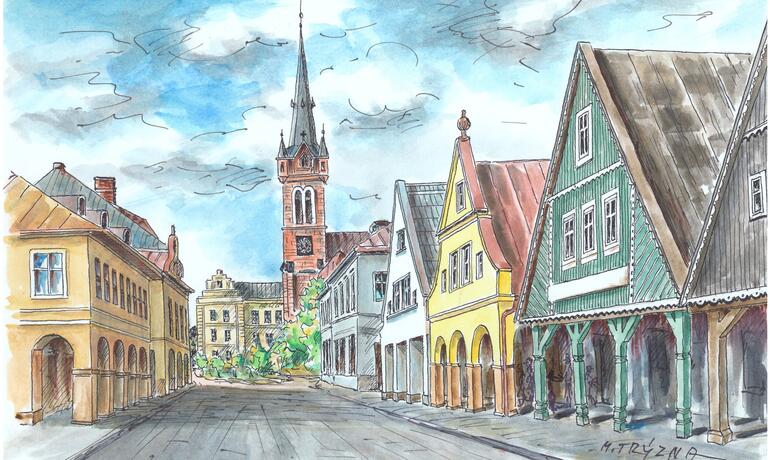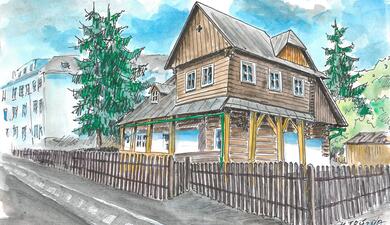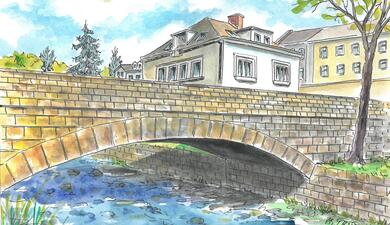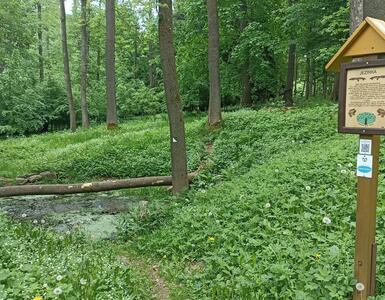Notable Monuments of Vrchlabi
Take a walk around Vrchlabi and learn about our town’s history, historical monuments and important personalities. The places marked on the map are furnished with commemorative tablets that will inform you about the events linked to specific places.
You can walk the whole route or divide it into smaller units and get to know a large piece of the city's history.
Sights and their significance
Palace
The Renaissance palace was built by the city’s founder, Krystof Gendorfer of Gendorf, commencing in 1546. The four corner towers were built by the House of Mirkovsky of Stropcice at the end of the 16th century. Until 1833 the palace was surrounded by a 12-m wide moat with three bridges. The Neo-Renaissance facelift and walls of the towers date back to the rebuilding of the palace by the House of Czernin-Morzin at the end of the 19th century, with a contribution by the renowned architect Josef Schulz. The palace has been the seat of the authorities since 1939.
Palace Chapel with the Tomb of the House of Czernin-Morzin
The chapel in the palace park was built by Countess Aloysia Czernin-Morzin in the Neo-Gothic style in 1887–1891 after a design by architect Stephan Tragl. The chapel interior with an altar and a sculpture of the Pieta (Virgin Mary holding the dead Christ) was made in a unified Neo-Gothic design. The tomb is located underneath the chapel and members of the House of Czernin-Morzin were buried here from 1892. After World War Two the chapel became a meeting house of the Czechoslovak Hussite Church.
Municipal Graveyard
The original graveyard in Vrchlabi, surrounded by a stone wall which used to separate the town’s upper and lower parts, used to be located around the old parish church of St. Lawrence. In 1805 the graveyard was closed down for sanitary reasons and a new graveyard was founded on the eastern slope above the monastery, on the town’s outskirts. Among the valuable tombs with interesting architecture, the Jerie tomb, built in the Neo-Gothic style, is the dominating structure. The other tombs display a variety of architectural styles of the 19th and the beginning of the 20th century.
Augustinian Monastery
The Augustinian monastery in Vrchlabi was established in 1705 by Maxmilian Morzin. The Baroque style building with its Neo-Classicist decorations was designed by architect Adam Auer. The monastery was completed in 1725. Its residential premises now house a Krkonose museum, operated by the Administration of the Krkonossky National Park. The monastery church is mostly used as a concert hall due to its great acoustics. It is decorated with the high altar in the Rococo style, 19 m in height, with a painting of St. Augustine and seven side altars with valuable Baroque decorations.
Old Town Hall
One of the oldest burgher houses in Vrchlabi was the first council hall in the town in the 16th–17th century. The upper timbered floor dates back to 1640s and the brick ground floor was redecorated at the beginning of the 19th century. At the beginning of the 20th century it housed the so-called Panorama – a room with a public stereoscope, the predecessor of the cinema.
Four Historical Houses
This complex of three gable houses features some of the oldest preserved buildings in the town. The inscription ‘WR’ and the year 1623 were found on one of the gable slabs. It is an example of the original architecture of the Krkonose towns, when arcades offered protection against bad weather and enabled the craftsman who lived and worked in these houses to offer their goods. The houses were saved in restoration works in 1976–1981. A half-timbered replica of the fourth house, which had been demolished in 1957, was built in 2009.
Josef Čapek - studies in Vrchlabí
Vrchlabí became the second home of Josef Čapek, a painter and writer, between 1901 and 1903. Josef's parents planned to convert his grandparents' mill in Hronov into a textile factory, so they enrolled their older son in the local German vocational weaving school. Josef soon finished his studies and started working in a textile factory in Úpice. Only later was he able to go to study at the School of Applied Arts in Prague. The building where Josef Čapek studied is now a vocational secondary school with a focus on engineering and gastronomy.
Church of St. Lawrence
This church was built in the Neo-Gothic style by a local builder, Eduard Zirm, on the site of a 14th century single-nave Gothic church, following a design by architect Stephan Tragl of Prague. The building works began in 1886 and finished in 1889. The three-nave hall is 30 m long and 18 m wide, with an adjacent 60 m tall spire. Five bells from the old church were used as a source of raw material for warfare purposes in 1942. Three new bells were acquired from a public collection in 2002.
Roman Catholic Vicarage
The Baroque vicarage was built in 1739–1740. The building originally had a high mansard roof with a central bay topped with a large dormer. Since 1845 the building has had only a low hip roof. The Rococo style facade was replaced with a Classicist facade and finally with a Neo-Baroque facade at the beginning of the 20th century. A Rococo statue of Virgin and Child with Saint Anne, formerly located in the square, can now be seen next to the side wall of the vicarage.
Municipal Hospital and Museum
This structure was built in 1815 as a municipal hospital. In 1856–1862 it was a temporary school building. From 1901 to 1941 it was the seat of the museums of the town and the Krkonose Union, the predecessors of today’s Krkonose Museum.
Strelnice Culture Centre
The name of the culture centre (‘Shooting Range’ in Czech) refers to the long history of the shooting association which existed here from 1846. The old pub was not large enough for the growing social and cultural activities of the association, and was therefore rebuilt in the Secession style by the local builders V. Krause and K. Hollmann into a municipal assembly hall in 1895–96 and 1903–04. It has since been used for cultural purposes, even though it has lost a lot of its original grandeur. In 1967 the film director Milos Forman chose it as the setting for his famous movie “Hori, ma panenko” (known as The Firemen’s Ball).
Josef Capek’s House
Wendt’s house, one of the first industrial buildings in Vrchlabi, was built in the austere Classicist style before 1829, later extended and used as a dyeing shop and fabric printing shop. It is the place where the future Czech painter, writer and fighter against fascism, Josef Capek, first stayed in 1901–1902. From here he attended the local weavers’ school.
Josef V. Kratochvíl
In the building that now houses the Municipal Library, Josef V. Kratochvíl worked as the first director of the Municipal Music School in Vrchlabí from 1945 to 1958.
New Town Hall
The Baroque town hall with its clock tower in the gable is the dominant feature of the main square. The bell at the front was used as an alarm bell or on festive occasions. The construction of one of the first stone buildings in the town was completed by builder Jan Jiri Seehak in 1737. The council used a large meeting hall on the first floor, and the ground floor was occupied by a pub.
The House with Seven Gables
One of the last timbered houses in the centre of Vrchlabi is an example of the then prevailing type of building in the town, based on rural architecture with a slight adjustment to suit life in town. The unique appearance of the house results from an attempt to best utilise all the rooms and drew the attention of the once famous Czech painter Josef Manes. The most interesting part is the attic, whose boarding and ceiling panels are decorated in multi-coloured painted stripes with plant and geometrical patterns. The folk decorations are a very specific resemblance of the style of ornamentation and illusive paintings known from church architecture. Later the house lost some of its extensions and not all of the original seven gables can be seen.
Viktor Kugler
Viktor was born in this house to the dressmaker Emilia Kugler on 6 June 1900. His destiny took him to Holland where he became one of the key personalities supporting the hiding Jewish Frank family during World War Two. He was imprisoned when their shelter was found. He is referred to as Harry Kraler in the famous diary of Anne Frank. He was awarded a high Israeli honorific, Righteous Among the Nations, for his bravery. He died on 14 December 1981 in Canada.
Petera’s House
Later the renowned automobile body factory of Ignatz Th. Petera, the predecessor of what is today the Skoda Auto factory, was established in 1864 in the nearby building no. 99. Before the end of the 19th century the company constructed this building, whose facade features artefacts from saddler and automobile body production. The building contained employee apartments, offices, workshops in the yard and the company shop on the ground floor. After 1904 most of the production was moved to Fügnerova Street.
Stone Bridge
The origins of this technical monument date back to the beginnings of the town, when over it led an important road from Studenec and Horni Branna to Lanov and Rudnik. Today’s appearance of the bridge dates back to 1856. After a hundred years’ flood in 1897, the statue of St. John of Nepomuk, dated 1709, was transferred to the eastern bridge head from its original location near the crossroad below the former paper mill. The bridge was reconstructed in 2006.
The Chateau
Also called Zamecek (The Chateau), this was the first paper mill in Vrchlabi, established in 1667. In the first decades of the 19th century, the pharmacist, natural scientist and chemist Vojtech Kablik used to carry out practical experiments with bleaching and dyeing of paper here. In 1851 the premises were bought by W. Jerie who opened a flax spinnery here in 1857. A part of the old paper mill was torn down and another part was rebuilt into a Neo-Romanesque style chateau. In the 1930s, it was the seat of the District Council. It is now a municipal property and after reconstruction it houses the ‘Morzin’ non-profit gallery, which presents contemporary Czech creative arts.
Viktor Cypers’s House
Viktor Cypers von Landrecy (*1857 †1930) lived and worked in this house. He was not only a member of a prominent family of Vrchlabí textile entrepreneurs, but also contributed significantly to the professional knowledge of the nature of the Krkonoše Mountains in the field of botany and zoology. He became the first manager of the library and collections of the Krkonoše Association, which he provided with space in his house from 1881. He became the first curator of the Krkonoše Museum in Vrchlabí, which is still functioning today.






